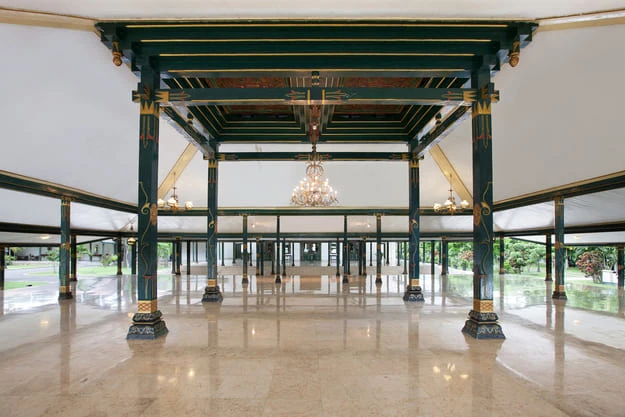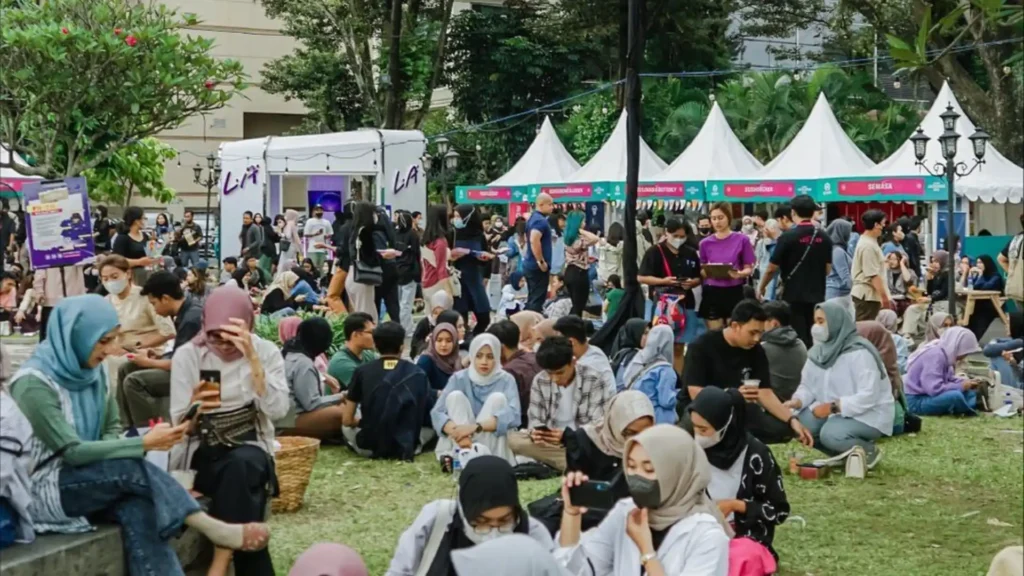The Pendopo Kedhaton Ambarrukmo is part of an 18th-century historical site that still stands strong today. Over 200 years old, this structure carries remnants of past grandeur—now preserved as a cultural masterpiece.
Pendopo represents a transformation through time, reflecting the life vision of the Javanese people. Much like the architecture of the Yogyakarta Palace, Pendopo Kedhaton Ambarrukmo is built upon the same philosophical foundation, the “Triloka Buana” concept.
This concept shapes the layout and structure of the Pendopo, embedding it with deep symbolism and life philosophy. Let’s take a closer look at the architectural beauty and meaning behind Pendopo Kedhaton Ambarrukmo.
Architectural Ornaments of the Pendopo Kedhaton Ambarrukmo
From an architectural and structural standpoint, the Pendopo features four main pillars known as Saka Guru, symbolizing the strength and stability of the four cardinal directions. According to various sources, this design reflects the Javanese belief in “Keblat Papat, Lima Pancer”—a philosophy that interprets the four pillars as protective forces against disaster, maintaining equilibrium through their central point of balance.
As previously noted, the Triloka Buana concept serves as the philosophical foundation behind the pendopo’s design. This concept emphasizes harmony among three realms: Svarloka (the upper world of the Gods), Bhuvarloka (the realm of the purified), and Bhurloka (the human world).
Originally applied to sacred structures such as temples, the Triloka Buana philosophy later influenced the layout of Pendopo buildings. In this context, the building is divided into three symbolic parts: the floor represents Palemahan or Bhurloka, the middle section is called Badan or Bhuvarloka, and the roof is referred to as Panuwunan or Svarloka.
Today, the Pendopo Agung Kedhaton Ambarrukmo reflects this traditional concept, enhanced with ornate decorative elements on each side. Historically, it was used by Sultan Hamengku Buwono VII to receive visiting dignitaries and royal guests.
Over time, the Keraton Ambarrukmo complex expanded and became a residential area for the royal family. Now, the Pendopo Agung Kedhaton Ambarrukmo stands as a preserved heritage site, embodying the grandeur and philosophical depth of Javanese royal architecture.
Putri Mirong
Putri Mirong is an ornamental carving found on the pillars supporting the Pendopo, depicting a princess (Putri) in a seated side profile. Rich in symbolism, this motif represents well-being, prosperity, and fertility, and is intricately adorned with the Arabic calligraphy of mim, ha, mim, dal—spelling the name Muhammad.
Umpak
Umpak, also known as Ompak or Padma, is the base beneath the supporting pillars. It symbolizes God as the Creator of the Earth and features a stylized calligraphic motif spelling Muhammad—represented by the Arabic letters mim, ha, mim, dal.
Sorot
Sorot means light and symbolizes the majesty of God. This ornament is found on the pillars of the Pendopo, featuring the same stylized calligraphic motif: mim, ha, mim, dal (spelling Muhammad). According to several sources, Sorot also carries a threefold philosophical meaning reflecting stages of human spiritual life at the time: faith (Iman), religion (Islam), and kindness (Ihsan).
Tumpal
Tumpal is an ornamental motif shaped like an equilateral triangle, typically arranged in a repeating pattern. It is commonly adorned in hues of green, gold, and red, symbolizing the radiant majesty of God. This motif is also known by several other names, including Banyu, Tumetes, Untu Walang, Saton, and Tlacapan. Tumpal is positioned at the junction between the main supporting pillars and the upper pillars of the Pendopo, forming a distinctive “T” shape in the architectural structure.
Lung
Lung, also known as Suluran, is a decorative motif rich in meaning. It carries two core interpretations, “Lung-tinulung,” which emphasizes mutual support and helping one another in goodness, and “Ulung-ulung,” which reflects the virtue of generosity that every human being should embody.
Ceplok Melati
The Ceplok Melati ornament, also referred to as Wajikan, draws inspiration from the jasmine flower. In Javanese tradition, jasmine embodies the philosophy “Rasa Melat Saka Njero Ati,” meaning to speak sincerely from the heart when expressing oneself. This meaningful ornament is typically placed at the base of the Pendopo pillars, featuring a blend of gold coloring with red streaks that enhance its visual and symbolic richness.
Tumpang Sari
The next architectural element of the Pendopo is Tumpang Sari, which refers to the layered wooden beams that support the roof structure. These layers are traditionally arranged in odd numbers—typically 3, 5, 7, or 9—as the Javanese believe that odd numbers bring better fortune and positive energy.
Mayangkara
Mayangkara is an ornamental element believed to ward off misfortune and protect against disaster. It is positioned within the Tumpang Sari section, located on the roof structure of the pendopo. The name Mayangkara is derived from a character in traditional Javanese wayang (puppet) performances, symbolizing protection and resilience.
Lowo Gumathung
In Javanese, “Lowo Gumathung” translates to “Hanging Bat”, a name that reflects the ornament’s placement—suspended in a position similar to a bat hanging upside down in a cave.
However, in terms of its form, the Javanese also refer to it as “Nanasan,” derived from the Arabic word “An-Nas,” meaning human. The philosophy behind this ornament emphasizes that to truly appreciate the beauty of life, humans must cultivate harmonious relationships with one another.
Dhadhapeksi
Dhadhapeksi is a decorative ornament that embodies elegance and beauty. It is intricately carved on the ceiling of the hall, located exactly at the center where the vertical and horizontal lines intersect. This ornament conveys the philosophy that goodness guides us toward greater ease and blessings in life.
To this day, Kedhaton Ambarrukmo remains committed to the timeless values established since its inception, such as Manunggaling Kawula Gusti (the unity between human and God) and Memayu Hayuning Bawana (preserving and enhancing the harmony between humans and nature).






